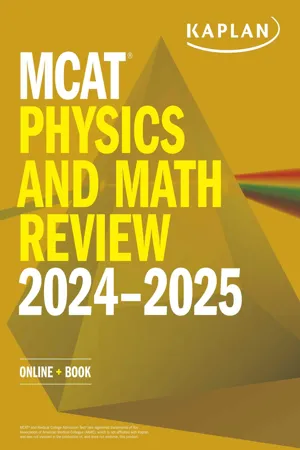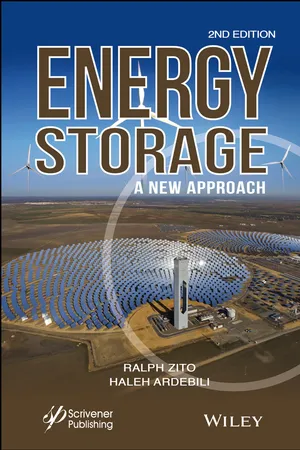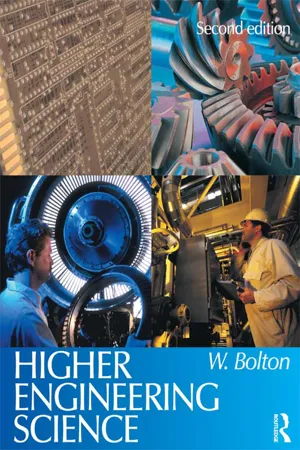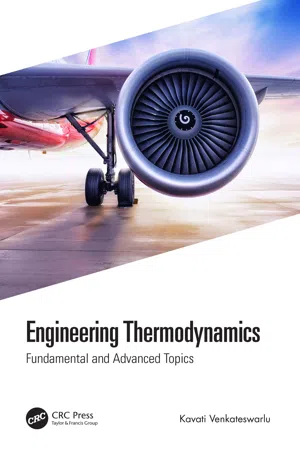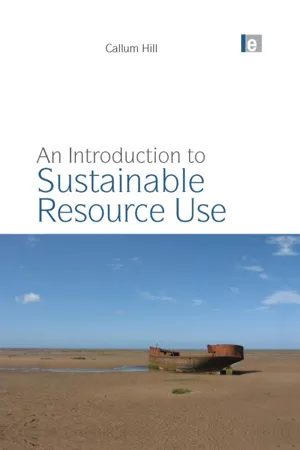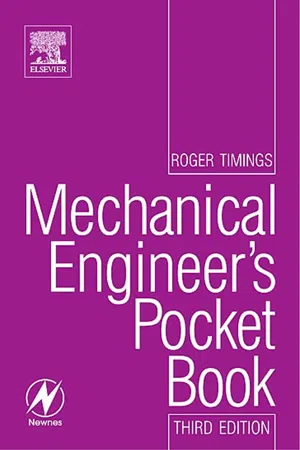Technology & Engineering
Work Energy Equation
The work-energy equation states that the work done on an object is equal to the change in its kinetic energy. This principle is based on the concept that work transfers energy to an object, resulting in a change in its motion. The equation is a fundamental tool in analyzing the relationship between work, energy, and the motion of objects.
Written by Perlego with AI-assistance
Related key terms
Related key terms
1 of 4
Related key terms
1 of 3
9 Key excerpts on "Work Energy Equation"
- No longer available |Learn more
MCAT Physics and Math Review 2024-2025
Online + Book
- (Author)
- 2023(Publication Date)
- Kaplan Test Prep(Publisher)
MCAT Physics and Math Review, we will identify additional ways to calculate power in electric circuits. For now, note that many of the devices we use every day—toaster ovens, light bulbs, phones, cars, and so on—are quantified by the rate at which these appliances transform electrical potential energy into other forms, such as thermal, light, sound, and kinetic energy.BRIDGE
Power is calculated in many different situations, especially those involving circuits, resistors, and capacitors. The equation for electric power is P = IV, where P is power, I is current, and V is electrical potential difference (voltage). This equation is discussed in Chapter 6 of MCAT Physics and Math Review. Power is always a measure of the rate of energy consumption, transfer, or transformation per unit time.Work–Energy Theorem
The work–energy theorem is a powerful expression of the relationship between work and energy. In its mechanical applications, it offers a direct relationship between the work done by all the forces acting on an object and the change in kinetic energy of that object. The net work done by forces acting on an object will result in an equal change in the object’s kinetic energy. In other words:Wnet = ΔK = Kf – Ki Equation 2.10This relationship is important to understand, as it allows one to calculate work without knowing the magnitude of the forces acting on an object or the displacement through which the forces act. If one calculates the change in kinetic energy experienced by an object, then—by definition—the net work done on or by an object is the same. Pressing the brake pedal in your car puts the work–energy theorem into practice. The brake pads exert frictional forces against the rotors, which are attached to the wheels. These frictional forces do work against the wheels, causing them to decelerate and bringing the car to a halt. The net work done by all these forces is equal to the change in kinetic energy of the car.In more general iterations, the work–energy theorem can be applied to changes in other forms of energy. In fact, the first law of thermodynamics is essentially a reiteration of the work–energy theorem, in which the change in internal energy (ΔU) is equal to the heat transferred into the system (Q) minus the mechanical work done by the system (W - eBook - ePub
Energy Storage
A New Approach
- Ralph Zito, Haleh Ardebili(Authors)
- 2019(Publication Date)
- Wiley-Scrivener(Publisher)
The history of the development of physical concepts is not the prime concern here, but some knowledge of their evolution does serve to bring more closely to our attention and scrutiny a better appreciation of terms that we employ daily. Sometimes it is necessary to begin understanding or developing a body of knowledge in order to make certain basic assumptions on an entirely intuitive basis. As scientifically unsatisfying as that may be, it is unavoidable at times. One could draw a weak comparison to plane geometry (Euclid) with regard to its various axioms and the declaration that parallel lines never meet. Even the concept of straight lines is rather intuitive in nature.Perhaps the best definition is that a force is required to change the motion of a body. Many problems arise in finding acceptable definitions for the basic parameters of physical science, namely, the abstract concepts of mass, time, force, and energy. However, we must learn to be satisfied with definitions that leave something to be desired in order to move on toward generating a working body of mechanics that enables us to design and build practical devices that serve our purposes.An interesting definition of energy comes from the Grolier Encyclopedia, which states:Energy can be measured in terms of mechanical work, but because not all forms of energy can be converted into useful work, it is more precise to say that the energy of a system changes by an amount equal to the net work done on the system … In classical physics, energy, like work, is considered a scalar quantity; the units of energy are the same as those of work. These units may be ergs, joules, watt-hours, foot-pounds, or foot-poundals, depending on the system of units being used. In modern science, energy and the three components of linear momentum are thought of as different aspects of a single four-dimensional vector quantity, much as time is considered to be one aspect of the four-dimensional space-time continuum … Energy exists in many different forms. The form that bodies in motion possess is called kinetic energy. Energy may be stored in the form of potential energy, as it is in a compressed spring. Chemical systems possess internal energy, which can be converted by various devices into useful work; for example, a fuel such as gasoline can be burned in an engine to propel a vehicle. Heat energy may be absorbed or released when the internal energy of a system changes while work is done on or by the system. (1993) - eBook - ePub
- William Bolton(Author)
- 2012(Publication Date)
- Routledge(Publisher)
5 Energy transfer5.1 IntroductionThis chapter is concerned with the energy transfers that can occur with mechanical systems. Energy can be transferred from one form to another by work being done or by heat transfer. Here we restrict the discussion to transfers involving work. There are many forms that energy can take and in this chapter potential energy, linear and angular kinetic energy and strain energy are discussed and the principles applied to the solution of mechanical system problems.5.1.1 Conservation of energyThere is a basic principle that is used in all discussions of energy and that is that energy is never lost, it is only transformed from one form to another or transferred from one object to another. This is the principle of the conservation of energy. In any process we never increase the total amount of energy, all we do is transform it from one form to another.5.2 WorkThe principle of the conservation of energy is that energy is never created or lost but only converted from one form to another. In all such conversions, the total amount of energy remains constant.Work is said to be done when the energy transfer takes place as a result of a force pushing something through a distance (Figure 5.1 ), the amount of energy transferred W being the product of the force F and the displacement s of the point of application of the force in the direction of the force.Figure 5.1 WorkWith force in newtons and distance in metres, the unit of work is the joule (J) with 1 J being 1 N m.Work done by a constant force W = Fs [1] Consider the work done by a force F when the resulting displacement s is at some angle 0 to the force (Figure 5.2 ). We can look at this in two equivalent ways. We can consider the displacement in the direction of the force F is s cos θ and so the work done is:work done = F × s cos θ [2] Figure 5.2 An oblique forceAlternatively, we can consider the force component acting in the direction of the displacement. The force can be resolved into two components, namely F cos θ in the direction of the displacement and F sin θ at right angles to it. There is no displacement in the direction of the F sin θ component and so it does no work. Hence the work done by the oblique force is solely due to the F cos θ - eBook - ePub
- A. L. Stanford, J. M. Tanner(Authors)
- 2014(Publication Date)
- Academic Press(Publisher)
This chapter introduces one of the most important and perhaps the most far-reaching of all principles in the sciences—the conservation of energy. A conservation principle is a rule or a natural law that specifies that the value of a physical quantity does not change during the course of a physical process but remains constant. The quantity that does not change is said to be conserved. The simplicity of conservation principles makes them concise expressions of natural law and powerful tools of scientific analysis. Conservation of energy is only one of a number of conservation principles that students of science or engineering will encounter. The significance and the usefulness of these principles should become apparent to the student as they are used to analyze and interpret physical phenomena.Of course, we have not yet defined energy. This chapter will introduce several physical quantities and concepts that are necessary for the understanding of energy and its associated conservation principle. First we will define work and describe how it may be accomplished and calculated. Then we will briefly consider power, a quantity that is useful in many practical applications. Next we will encounter energy in its mechanical forms, namely, kinetic and potential energies, and see how these quantities are related to work. Finally, we will see how kinetic and potential energies are used to express the conservation of energy principle, the essential physical relationship of this chapter.5.1 Work
In the nonscientific world, work is often thought of in terms of some physical or mental effort. In physics, however, the term work is defined precisely. Doing work requires the use of force, and work on a body does not take place without displacement of that body. We will begin with a simple situation in which work occurs: work done by a constant force.Work by a Constant Force
Suppose a constant force F is applied to a particle that moves in a straight line, say along the x axis from x 1 to x 2 through a displacement of Δr = (x 2 – x 1 )î Δx î. The work done by the force F on the particle is defined to be the product of the magnitude of the displacement and the magnitude of that component of the force that is in the direction of the displacement. In Figure 5.1 the force F is applied to a particle at an angle θ measured from the x axis. As the particle is displaced by Δr = Δx î, the vector component of force in the direction of the displacement isFxî. Then the work W done by the force F on the particle in displacing it by Δr = Δx - eBook - ePub
Engineering Thermodynamics
Fundamental and Advanced Topics
- Kavati Venkateswarlu(Author)
- 2020(Publication Date)
- CRC Press(Publisher)
In engineering thermodynamics, the focus will be on work-producing devices such as internal combustion engines and turbines. Hence, it is always suitable to consider such work as positive. That is, the work done by the system is positive, and the work done on the system is negative. In certain cases, however, it is convenient to regard the work done on the system to be positive. To reduce the possibility of misunderstanding in any such case, the direction of energy transfer is shown by an arrow on a sketch of the system, and work is regarded as positive in the direction of the arrow. It is necessary to know how the force varies with the displacement. This brings out an important idea about work.3.8 First Law of Thermodynamics
The first law of thermodynamics (conservation of energy principle) establishes the relationships among the various forms of energy and energy interactions such as heat Q and work W during a process. The first law of thermodynamics states that energy is neither created nor destroyed during a process; it gets transformed from one form to the other. When an electrical energy is supplied to a motor, it will rotate a pump circulating the fluid. In this case, electrical energy is converted to kinetic energy (rotation of the shaft). A speeding vehicle possesses kinetic energy, if the brake is applied it comes to rest slowly and at rest, it possesses potential energy. The loss in kinetic energy equals the increase in potential energy when the air resistance is negligible, thus confirming the conservation of energy principle for mechanical energy.The conservation of energy principle can be demonstrated with the help of the processes that involve either heat or work interactions or simultaneous heat and work interactions as well. In one case, we consider a process that involves heat transfer but no work interactions such as heating of a metal bar in a furnace. Owing to heat transfer to the metal bar, its energy increases. The increase in the total energy of the metal bar will be equal to the amount of heat transferred to it. Similarly, in the case of heating of water in a steam boiler, if 100 kJ of heat is transferred to the water from the furnace and 10 kJ of it is lost from the water to the ambient surroundings, the increase in energy of the water becomes equal to the net heat transfer to water, i.e., 90 kJ. - eBook - ePub
Physics of Cryogenics
An Ultralow Temperature Phenomenon
- Bahman Zohuri(Author)
- 2017(Publication Date)
- Elsevier(Publisher)
These may be called energy transfer or energy interactions and they bring about changes in the properties of the system. Positive work occurs when the system transfers energy to its surroundings by some mechanical or electrical process. Positive heat transfer occurs when the surroundings transfer thermal energy to the system. Normally a temperature difference is the driving potential that moves thermal energy into or out of a system.4.2. Definition of Work
The formal definition of work is “a force acting through a distance.” When a system undergoes a displacement due to the action of a force, work is taking place and the amount of work is equal to the product of the force and the displacement in the direction of the force. The term work is so common with many meanings in the English language that it is important to be very specific in its thermodynamic definition.4.2.1. Work Is Done by a Force as It Acts Upon a Body Moving in the Direction of the Force
If the force acts, but no movement takes place, no work is done. Work is performed by the expanding exhaust gases after combustion occurs in a cylinder of an automobile engine as shown in Fig. 4.1 . In this case the energy produced by the combustion process can be transferred to the crankshaft by means of the connecting rod, in the form of work. Therefore, the work can be thought of as energy being transferred across the boundary of a system, the system being the gases in the cylinder.A similar concept is the work done in the turbine to generate electricity in a nuclear power plant. The gas pressure rotates the turbine blades producing a torque that turns a generator. Thermal energy is transferred from the reactor core to the steam generator in the first loop. The second loop then uses this steam to drive the turbine. See Fig. 4.2 - eBook - ePub
- Callum Hill(Author)
- 2012(Publication Date)
- Routledge(Publisher)
Energy is used to move things, to drive machinery, to provide heat and electricity, and to stay alive. Without energy there would be no change and time would not exist. But what exactly is it? For many years energy was seen as a mysterious force that acted upon matter and somehow gave it ‘life’ and it was given a name that reflected this idea, ‘vis viva’. Even now, much misunderstanding exists; it is common to see the words ‘energy’ and ‘power’ used interchangeably although they mean different things, or references to energy ‘consumption’, whereas energy is always conserved. There is no doubt that something is being consumed when we use energy and we shall examine later in this chapter what this something is.To quote the Nobel Prize-winning physicist Richard Feynman, ‘It is important to realize that in physics today, we have no knowledge of what energy is.’ But if we are not exactly sure what energy is, we certainly know what it does, we can describe how it behaves, what properties it exhibits and how it interacts with matter.A standard textbook definition of energy is ‘energy represents the capacity to do work’. Although true, this is not necessarily very helpful when trying to get a mental picture of energy. Perhaps a better definition is the rather dry, but accurate, state- ment ‘energy has the ability to bring about transformation in a system’. The system represents the particular part of the universe which is the subject of study, and this might be an engine, a power station, a tree or a recycling process (we’ll look at this a little later). Energy transformation causes change, which is why energy and time are interwoven.Let us return for a moment to the narrower definition of energy as the ‘capacity to do work’. Work is what happens when something moves (work = force × distance). Work involves the organized motion of assemblies of atoms or molecules.A bicycle is clearly an organized assembly of molecules and atoms, and by pedal- ling this assembly, motion will result. The bicycle has been given kinetic energy by the contraction and extension of leg muscles whose chemical energy is derived ulti- mately from sunlight. Sunlight is converted into the movement of a bicycle through the mechanics of legs (plus a few other conversions along the way). - eBook - ePub
- Roger Timings(Author)
- 2005(Publication Date)
- Newnes(Publisher)
3Engineering Dynamics
3.1 Engineering dynamics
As stated at the beginning of Chapter 2 , engineering mechanics can be divided into statics and dynamics . Chapter 3 is concerned with dynamics which is the study of objectsin motion .3.2 Work
When a force is applied to a body so that it causes the body to move, the force is said to be doing work . The work done is the product of the distance moved in metres (m) and the applied force in newtons (N) measured in the direction of motion. Therefore the work done is measured in newton metres and the unit of work is joule (J) where 1 Nm = 1 J .Figure 3.1(a) shows a body is being moved by a force F along a horizontal plane. Since the force is acting on the body parallelto the horizontal plane, the work done is product of the force F (N) and the distance s (m). If the force is 50 N and the distance is 3 m, then the work done is:Figure 3.1 Work. (a) Work done by a force F . (b) Work done by the force F H .50 N × 3m = 150Nm = 150 JIn Fig. 3.1(b) the force is inclined through the angle a to the direction of motion. In this case the force vector has to be resolved into its vertical and horizontal components as shown. The component force that is parallel to the direction of motion of the body is F cos ∝ . Therefore the work done is s × F cos ∝ joules. If the force (F) is again 50 N, the distance (s) is again 3 m and the angle ∝ is 30° the work done will be:W = 3m × 50 N × 0 .866 = 129 .9Nm = 129.9 J3.3 Energy
Anything capable of doing work is said to posses energy . Energy exists in various forms and may be considered as ’stored work’ awaiting to be used. For example:•Chemical energy is absorbed or released when a reaction occurs (e.g. the combustion of fossil fuels).•Atomic energy isliberated by splitting or combining atomic particles. Splitting atomic particles is called fission and combining atomic particles is called fusion - Alexander V. Dimitrov(Author)
- 2017(Publication Date)
- CRC Press(Publisher)
low quality ) heat. Work is treated as directed, useful, and organized form of motion while heat is considered to be coproduced by aimless movable quasi-particles due to particle interaction (Dimitrov A.V., 2015). During energy-based interactions, all system parameters can vary. These are•Available quantity of matter, electrical quantity, volume occupied by matter, and chaos of motion •Temperature, pressure, electric potential, and internal energyThe first group of parameters is called generalized displacements (or coordinates ) while the second one—generalized forces or potentials.In brief, energy exchange between bodies and energy fields is measured introducing “energy quantity.” The SI measure used is Joule (1 [J] = 1 Nm) and its derivatives (1 kJ = 103 J, 1 MJ = 106 J, 1 GJ = 109 J, and 1 TJ = 1012 J).* There are also other systems of energy measurement such as the IP system used in the Anglo-Saxon world or the antiquated but still popular system “kg–sm–h.” The link between different measurement systems is given in Table A.2 —see the Appendices .1.1.3.2 Thermodynamic SystemTable 1.1 Energy Forms and Their Corresponding Works Interactions Energy Forms Mechanical interaction ⇒ Mechanical energy Thermal interaction ⇒ Thermal energy Electromagnetic interaction ⇒ Electrical energy Chemical interaction ⇒ Chemical energy Nuclear interaction ⇒ Nuclear energy According to modern science, a thermodynamic system (TDS) is a set of bodies and energy fields exchanging energy and mass between each other. It possesses expressed geometrical boundaries called “control surfaces ” while its interior is treated as a “control volume. ” All material objects outside the control surface constitute TDS surroundings (environment).Considering links with the environment, the TDSs may be classified in three groups:•Insulated TDS
Index pages curate the most relevant extracts from our library of academic textbooks. They’ve been created using an in-house natural language model (NLM), each adding context and meaning to key research topics.
Explore more topic indexes
Explore more topic indexes
1 of 6
Explore more topic indexes
1 of 4
